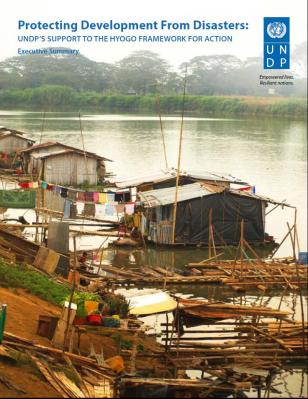DRR Global Impact study
DRR Global Impact study
May 2, 2016
This publication highlights the results that UNDP has achieved since 2005 in supporting disaster risk reduction (DRR) and recovery in countries prone to disasters. The first comprehensive report outlining UNDP’s contribution to the implementation of the Hyogo Framework for Action, the report illustrates the reforms that countries and communities are undertaking, with UNDP support, to become more disaster resilient.
In the last 50 years, the vast majority of those affected by disasters have resided in low and middle income countries. Besides causing death and suffering, disasters erase development gains, destroy infrastructure, restrict access to education and health care, undermine livelihoods, and exacerbate vulnerabilities to further natural hazard events. To break this cycle, the Hyogo Framework for Action, endorsed by 168 countries, calls on Member States to build resilience and reduce disaster risk.
With its operational presence in 177 countries and a wealth of technical expertise, UNDP was tasked by the United Nations General Assembly to support Member States in preventing and preparing for disasters. Since the Hyogo Framework for Action was put into effect, UNDP has devoted its efforts to helping countries achieve its ambitious outcomes, which include the substantial reduction of disaster losses.
From 2000-2012, at least 90 countries have been impacted by disasters affecting an average of more than 100,000 people in each event. UNDP is actively engaged in 81 of these 90 countries and in a typical year works in over 50 countries to help reduce disaster risk.
Highlights
- Through UNDP's early warning system support to the Philippines, within minutes of a 9.0 earthquake off the coast of Japan on 11 March 2011, more than 120,000 people living in an exposed coastal community in the Philippines were alerted to a possible tsunami through messages received on their mobile phones.
- In Uzbekistan and the former Yugoslav Republic of Macedonia, UNDP has supported the design of mobile phone apps which allow users to receive updates on hazards and disasters as they happen. With a touch of the map, users can find out the status of an event, receive tips on staying safe, explore past hazard events, and access key contact information, such as emergency services.
- In Mozambique, through income-generation and food security-related projects, combined with extensive advocacy and public awareness, UNDP has encouraged resettled communities not to return to flood-prone areas. While only one component of a much larger intervention, the initiative did contribute to a reduction in flood related mortality in 2010, which was less than 25 percent of the 10 year average.
- In the Dominican Republic, with UNDP’s support, the country now boasts a national seismic risk reduction plan, and a national fund for the prevention, mitigation and response to disasters. Moreover, the National Development Strategy 2010-2030, incorporates risk reduction as both a crosscutting issue and as one of its main pillars.
Read the report online

 Locations
Locations